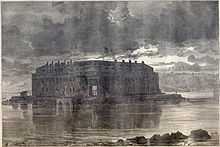Fort Lafayette

Fort Lafayette was an island coastal fortification in the Narrows of New York Harbor, built offshore from Fort Hamilton at the southern tip of what is now Bay Ridge in the New York City borough of Brooklyn. The fort was built upon a natural island known as Hendrick's Reef.
Construction on the fort began during the War of 1812 and was finally completed in 1818, the fort originally named Fort Diamond was renamed in 1825 to celebrate the Marquis de La Fayette, a hero of the American Revolution who was returning to his native France after his year-long grand tour of the United States.
Construction of the Verrazano-Narrows Bridge caused the fort's destruction in 1960; the Brooklyn-side bridge pillars now occupy the fort's former foundation site.
Civil War prison


Before 1861, the fort's 72 heavy cannon commanded the primary approaches to the harbor, but during the Civil War, the casemates were used to house Confederate prisoners of war and politicians opposed to the administration's policies, detained under Abraham Lincoln's selective suspension of the writ of habeas corpus. Fort Lafayette came to be known as the "American Bastille".[1]
Robert Cobb Kennedy formerly a captain in the 1st Louisiana Regular Infantry CSA was one of the Confederate conspirators in the plot to burn New York on November 25, 1864 and was the only one caught. He was imprisoned and hanged at the fort on March 25, 1865. The plot to burn New York was to be retaliation for Sherman burning Atlanta.[2][3][4]
Francis Key Howard, grandson of Francis Scott Key, was a newspaper editor of the Baltimore Exchange, a newspaper sympathetic to the southern cause. He was arrested on September 13, 1861 by U.S. major general Nathaniel Prentice Banks on the direct orders of general George B. McClellan enforcing the policy of President Abraham Lincoln. The basis for his arrest was for writing a critical editorial in his newspaper of Lincoln's suspension of the writ of habeas corpus, and the fact that the Lincoln administration had declared martial law in Baltimore and imprisoned without due process, George William Brown the mayor of Baltimore, Congressman Henry May, the police commissioners of Baltimore and the entire city council.[5] He was then transferred to Fort Lafayette and from there to Fort Warren in Boston.[6][7]
Later use
Rebuilt after a catastophic fire in 1868, the fort was later used for ammunition storage and transfer until World War II. It was demolished in 1960 when the island was used for the base of the Brooklyn tower of the Verrazano-Narrows Bridge.
.jpg)
References
- ↑ The Political Prisoners.; A Day At Fort Lafayette. List Of The Prisoners. Published: September 24, 1861
- ↑ The Plot To Burn New-York.; Arrest Of Four Conspirators. They Are To Be Tried As Spies. Court-Martial At Fort Lafayette. Travels of a Hotel-Keeper. The Testimonial Business An Imposition on Ill.-Paid Clerks. The New York Times. Published: January 17, 1865
- ↑ Brandt, Nat (1986). The Man Who Tried to Burn New York. York State Books. Syracuse, NY: Syracuse University Press. ISBN 0-8156-0207-3
- ↑ Marshall, John A., American Bastille: A history of the illegal arrests and imprisonment of American citizens during the late Civil War (Civil liberties in American history) ISBN 1-4179-3078-0
- ↑ Lincoln on Democracy By Mario Matthew Cuomo, Abraham Lincoln, Harold Holzer, G. S. Boritt p. 217 Publisher: Fordham University Press; Revised edition (September 1, 2004) Language: English ISBN 0-8232-2345-0
- ↑ American Bastille (Civil liberties in American history) by John A. Marshall. Publisher: Da Capo Press Inc; 4th edition (November 30, 1970) Language: English ISBN 0-306-71963-0 ISBN 978-0306719639
- ↑ United States War Dept., United States. Record and Pension Office, United States. War Records Office, et al. The war of the rebellion: a compilation of the official records of the Union and Confederate armies. Series 2 - Volume 2. (Washington, D.C. Government Printing Office, 1894): 778-786.
External links
- New York State Military Museum
- Portals to Hell, book
- The New York Times 1903
- List of prisoners, 1861
- Public Works of the Navy
- American Bastille (1881)
Coordinates: 40°36′30″N 74°02′19″W / 40.60833°N 74.03861°W